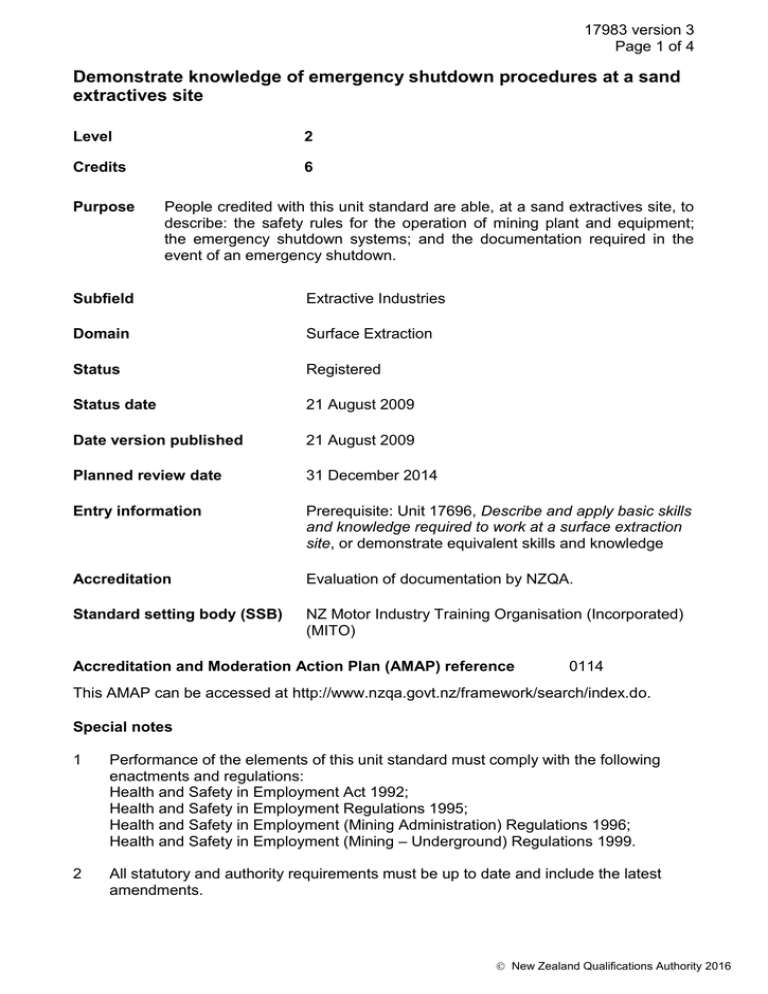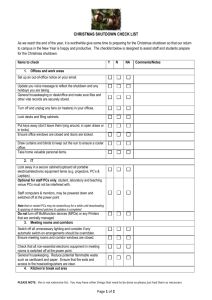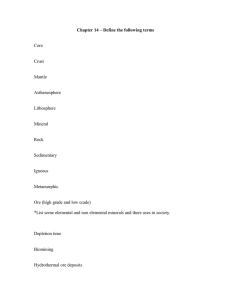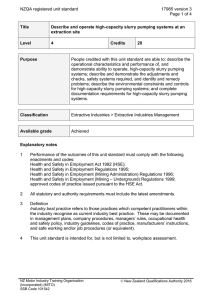Demonstrate knowledge of emergency shutdown procedures at a sand extractives site
advertisement

17983 version 3 Page 1 of 4 Demonstrate knowledge of emergency shutdown procedures at a sand extractives site Level 2 Credits 6 Purpose People credited with this unit standard are able, at a sand extractives site, to describe: the safety rules for the operation of mining plant and equipment; the emergency shutdown systems; and the documentation required in the event of an emergency shutdown. Subfield Extractive Industries Domain Surface Extraction Status Registered Status date 21 August 2009 Date version published 21 August 2009 Planned review date 31 December 2014 Entry information Prerequisite: Unit 17696, Describe and apply basic skills and knowledge required to work at a surface extraction site, or demonstrate equivalent skills and knowledge Accreditation Evaluation of documentation by NZQA. Standard setting body (SSB) NZ Motor Industry Training Organisation (Incorporated) (MITO) Accreditation and Moderation Action Plan (AMAP) reference 0114 This AMAP can be accessed at http://www.nzqa.govt.nz/framework/search/index.do. Special notes 1 Performance of the elements of this unit standard must comply with the following enactments and regulations: Health and Safety in Employment Act 1992; Health and Safety in Employment Regulations 1995; Health and Safety in Employment (Mining Administration) Regulations 1996; Health and Safety in Employment (Mining – Underground) Regulations 1999. 2 All statutory and authority requirements must be up to date and include the latest amendments. New Zealand Qualifications Authority 2016 17983 version 3 Page 2 of 4 3 Definition Industry best practice refers to those practices which competent practitioners within the industry recognise as current industry best practice. These may be documented in management plans, industry best practice or requirements, managers' rules, occupational health and safety policy, industry guidelines, codes of practice, manufacturers' instructions, safe working and/or job procedures (or equivalent). Elements and performance criteria Element 1 Describe the safety rules for the operation of mining plant and equipment at a sand extractives site. Performance criteria 1.1 The safety rules and procedures are described in relation to mining plant and equipment on-site and industry best practice. Range 1.2 The safety rules and procedures are described in relation to processing plant and equipment on-site and industry best practice. Range 1.3 may include but is not limited to – tailings lines and pumps, slurry pumping system and pumps, cyclones. The safety rules and procedures are described in relation to stockpiles. Range 1.5 may include but is not limited to – primary feed systems, magnetic separators, gravity separation systems, scrubbers, cyclones, recyclable water systems, tailings disposal, screening systems. The safety rules and procedures are described in relation to slurry pumping plant and equipment on-site and slurry pumping operation. Range 1.4 may include but is not limited to – bucket wheel excavators, belt wagons, hopper/cable reel cars, moveable conveyors, main conveyors, stackers, mining ancillary equipment, dredges. may include but is not limited to – feeders, stackers, re-claim, operating on stockpiles. The safety rules and procedures are described in relation to control rooms and systems on-site. Range may include but is not limited to – computer system controls, communications, re-booting the system, alarm system. New Zealand Qualifications Authority 2016 17983 version 3 Page 3 of 4 Element 2 Describe the emergency shutdown systems at a sand extractives site. Performance criteria 2.1 The emergency shutdown procedures are described in relation to mining plant and equipment on-site. Range 2.2 The emergency shutdown procedures are described in relation to processing plant and equipment on-site and industry best practice. Range 2.3 may include but is not limited to – bucket wheel excavators, dredges, belt wagons, hopper/cable reel cars, moveable conveyors, main conveyors, stackers, mining ancillary equipment. may include but is not limited to – primary feed systems, magnetic separators, gravity separation systems, scrubbers, cyclones, recyclable water systems, tailings disposal, screening systems. The emergency shutdown procedures are described in relation to slurry pumping plant and equipment on-site and slurry pumping operation. Range may include but is not limited to – tailings lines and pumps, slurry pumping systems and pumps, cyclones. 2.4 The emergency shutdown for stockpiles is described in relation to feeders, stackers, re-claim, and operating on stockpiles. 2.5 The emergency shutdown procedures for control rooms and control systems on-site are described in relation to computer system controls and communications. Element 3 Describe the documentation required in the event of an emergency shutdown at a sand extractives site. Performance criteria 3.1 The emergency shutdown documentation that must be completed and reported is described in accordance with industry best practice. Please note Providers must be accredited by NZQA, or an inter-institutional body with delegated authority for quality assurance, before they can report credits from assessment against unit standards or deliver courses of study leading to that assessment. Industry Training Organisations must be accredited by NZQA before they can register credits from assessment against unit standards. New Zealand Qualifications Authority 2016 17983 version 3 Page 4 of 4 Accredited providers and Industry Training Organisations assessing against unit standards must engage with the moderation system that applies to those standards. Accreditation requirements and an outline of the moderation system that applies to this standard are outlined in the Accreditation and Moderation Action Plan (AMAP). The AMAP also includes useful information about special requirements for organisations wishing to develop education and training programmes, such as minimum qualifications for tutors and assessors, and special resource requirements. Comments on this unit standard Please contact the NZ Motor Industry Training Organisation (Incorporated) (MITO) info@mito.org.nz if you wish to suggest changes to the content of this unit standard. New Zealand Qualifications Authority 2016






